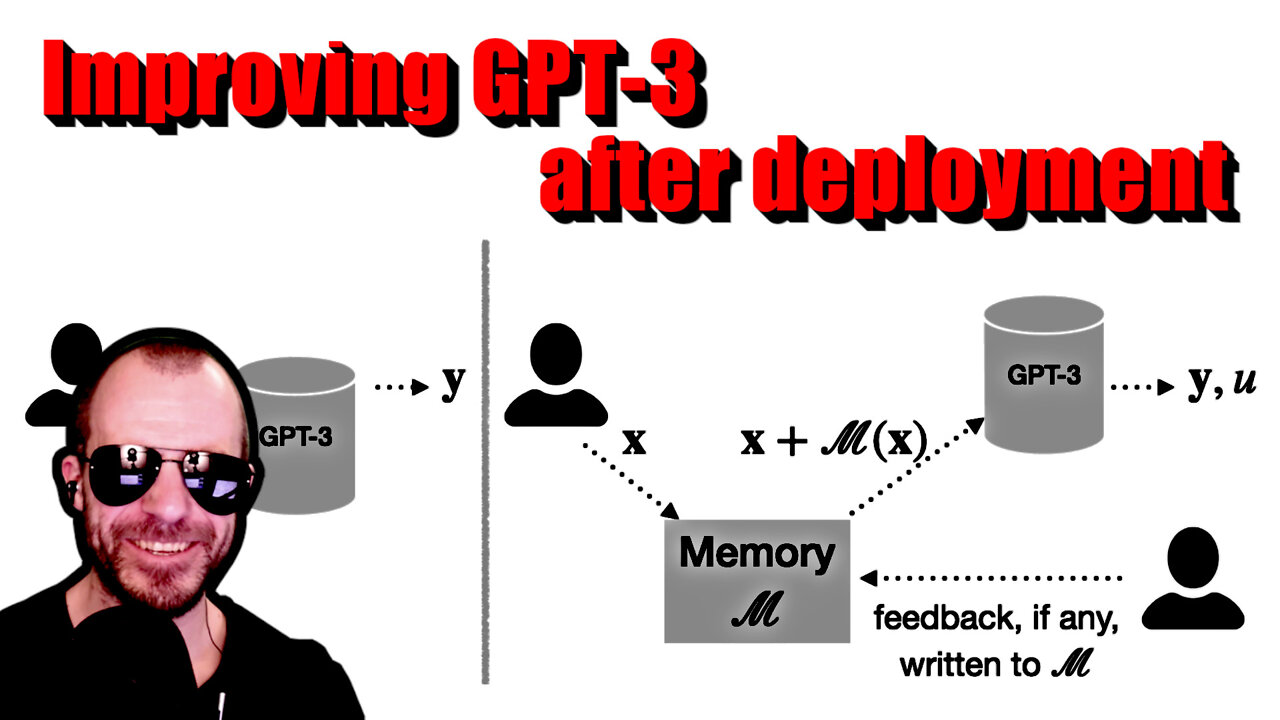Premium Only Content

Memory-assisted prompt editing to improve GPT-3 after deployment (Machine Learning Paper Explained)
#nlp #gpt3 #prompt
Large language models such as GPT-3 have enabled many breakthroughs and new applications recently, but they come with an important downside: Training them is very expensive, and even fine-tuning is often difficult. This paper presents an adaptive method to improve performance of such models after deployment, without ever changing the model itself. This is done by maintaining a memory of interactions and then dynamically adapting new prompts by augmenting them with memory content. This has many applications, from non-intrusive fine-tuning to personalization.
Sponsor: Introduction to Graph Neural Networks Course
https://www.graphneuralnets.com/p/int...
OUTLINE:
0:00 - Intro
0:40 - Sponsor: Introduction to GNNs Course (link in description)
1:30 - Paper Overview: Improve GPT-3 after deployment via user feedback
5:30 - Proposed memory-based architecture
13:00 - A detailed look at the components
15:00 - Example tasks
24:30 - My concerns with the example setup
26:20 - Baselines used for comparison
29:50 - Experimental Results
34:20 - Conclusion & Comments
Paper: https://arxiv.org/abs/2201.06009
Code & Data: https://github.com/madaan/memprompt
Abstract:
Large LMs such as GPT-3 are powerful, but can commit mistakes that are obvious to humans. For example, GPT-3 would mistakenly interpret "What word is similar to good?" to mean a homonym, while the user intended a synonym. Our goal is to effectively correct such errors via user interactions with the system but without retraining, which will be prohibitively costly. We pair GPT-3 with a growing memory of recorded cases where the model misunderstood the user's intents, along with user feedback for clarification. Such a memory allows our system to produce enhanced prompts for any new query based on the user feedback for error correction on similar cases in the past. On four tasks (two lexical tasks, two advanced ethical reasoning tasks), we show how a (simulated) user can interactively teach a deployed GPT-3, substantially increasing its accuracy over the queries with different kinds of misunderstandings by the GPT-3. Our approach is a step towards the low-cost utility enhancement for very large pre-trained LMs. All the code and data is available at this https URL.
Authors: Aman Madaan, Niket Tandon, Peter Clark, Yiming Yang
Links:
Merch: store.ykilcher.com
TabNine Code Completion (Referral): http://bit.ly/tabnine-yannick
YouTube: https://www.youtube.com/c/yannickilcher
Twitter: https://twitter.com/ykilcher
Discord: https://discord.gg/4H8xxDF
BitChute: https://www.bitchute.com/channel/yann...
LinkedIn: https://www.linkedin.com/in/ykilcher
BiliBili: https://space.bilibili.com/2017636191
If you want to support me, the best thing to do is to share out the content :)
If you want to support me financially (completely optional and voluntary, but a lot of people have asked for this):
SubscribeStar: https://www.subscribestar.com/yannick...
Patreon: https://www.patreon.com/yannickilcher
Bitcoin (BTC): bc1q49lsw3q325tr58ygf8sudx2dqfguclvngvy2cq
Ethereum (ETH): 0x7ad3513E3B8f66799f507Aa7874b1B0eBC7F85e2
Litecoin (LTC): LQW2TRyKYetVC8WjFkhpPhtpbDM4Vw7r9m
Monero (XMR): 4ACL8AGrEo5hAir8A9CeVrW8pEauWvnp1WnSDZxW7tziCDLhZAGsgzhRQABDnFy8yuM9fWJDviJPHKRjV4FWt19CJZN9D4n
-
 LIVE
LIVE
Game On!
15 hours agoHAPPY FOOTBALL FRIDAY! NFL Week 14 Betting Preview!
461 watching -

Crypto Power Hour
10 hours ago $2.74 earnedBlockchain Solutions w/ U.S. Healthcare Featuring Solum Global
21.2K9 -
 1:18:24
1:18:24
The Illusion of Consensus
1 month ago“Your Math Is WRONG” - Mark Cuban GRILLED Over His NBA COVID Vaccine Mandate | Part 2
3.15K7 -
 14:17
14:17
RTT: Guns & Gear
16 hours ago $2.33 earnedBest Budget RMR Red Dot 2025? Gideon Optics Granite Review
5.58K3 -
 LIVE
LIVE
BEK TV
23 hours agoTrent Loos in the Morning - 12/05/2025
270 watching -
 LIVE
LIVE
The Bubba Army
22 hours agoWill Michael Jordan TAKE DOWN NASCAR - Bubba the Love Sponge® Show | 12/05/25
1,494 watching -
 35:55
35:55
ZeeeMedia
14 hours agoPfizer mRNA in Over 88% of Human Placentas, Sperm & Blood | Daily Pulse Ep 156
10.1K100 -
 LIVE
LIVE
Pickleball Now
4 hours agoLive: IPBL 2025 Day 5 | Final Day of League Stage Set for Explosive Showdowns
223 watching -
 9:03
9:03
MattMorseTV
17 hours ago $19.08 earnedIlhan Omar just got BAD NEWS.
39.2K92 -
 2:02:41
2:02:41
Side Scrollers Podcast
21 hours agoMetroid Prime 4 ROASTED + Roblox BANNED for LGBT Propaganda + The “R-Word” + More | Side Scrollers
142K14